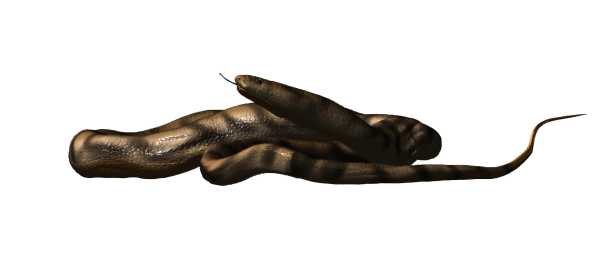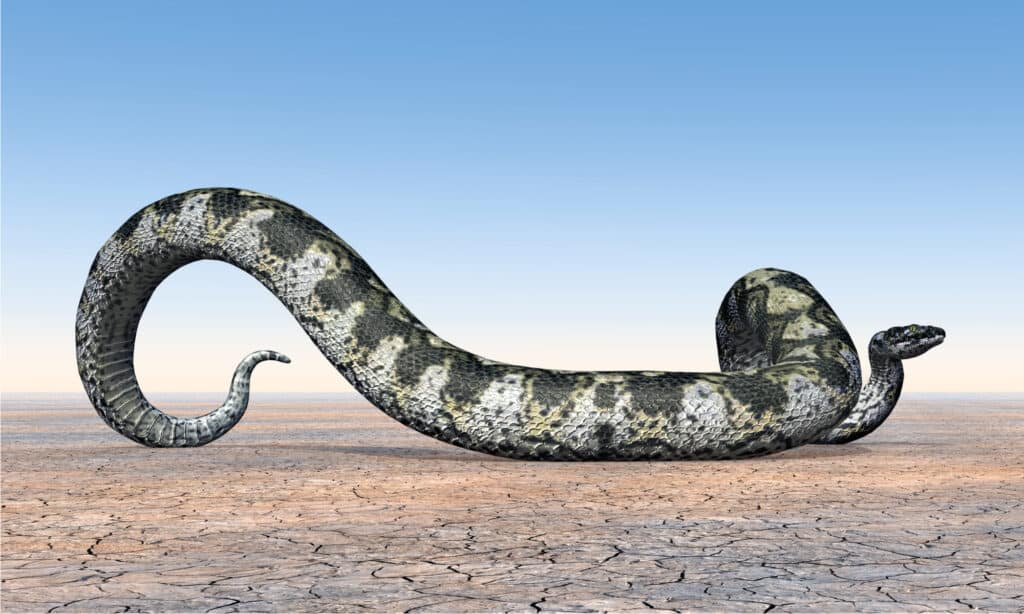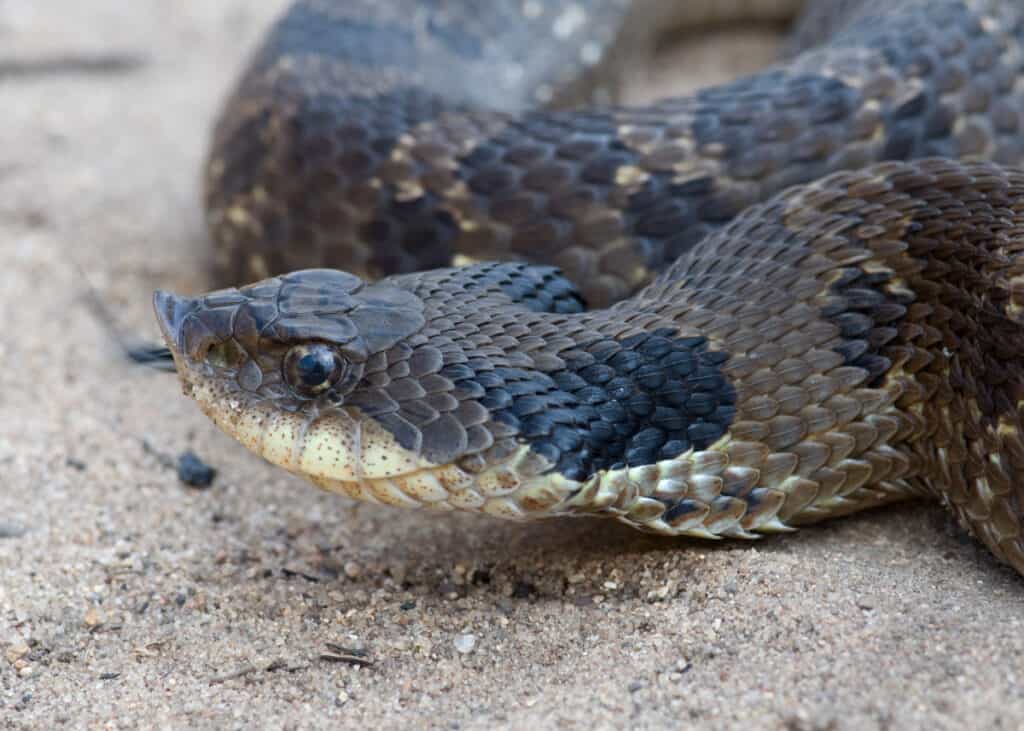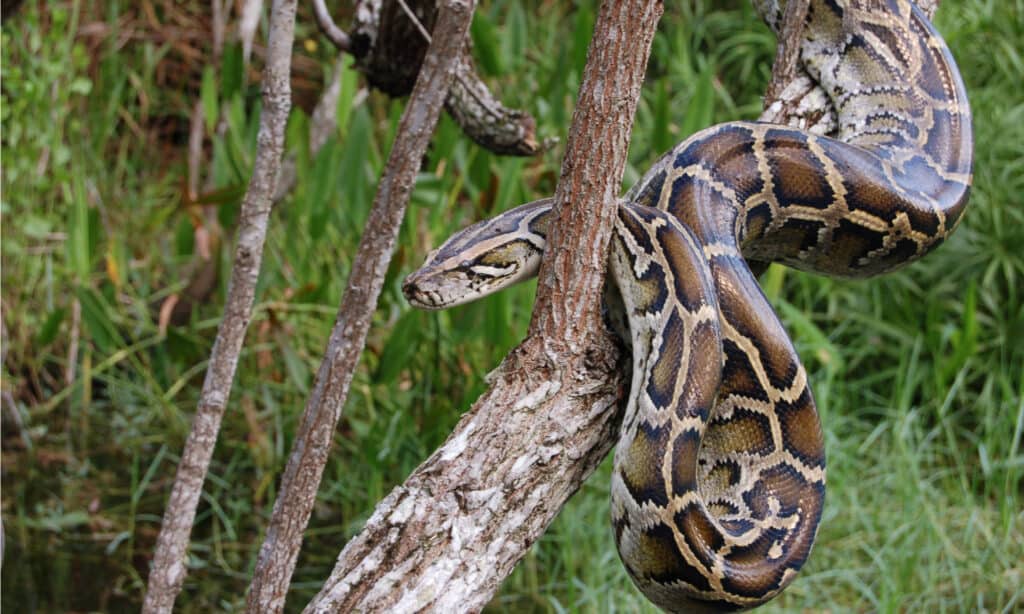Key Points:
- While studies showed that snakes originated in the Paleocene Epoch between 65-56 million years ago, the most recent discovery dates the oldest snakes back to 167 million years ago.
- The remains of the oldest recorded snake, aged 167 million years ago, were found in Southern England.
- The 60-million-year-old Titanboa was the largest snake to ever exist, growing up to 50 feet long and weighing up to 2,500 pounds.
Limbless, elongated, legless, yet one of the most feared animals, snakes, are one of nature’s wonders and mysteries. Although they seem to have a flexible appearance, snakes are vertebrates with long, long rib cages that protect their bodies all over. There are over 3,500 named species of snakes worldwide, with only 10-15% of them being venomous and 85% non-venomous, despite having a reputation for being “deadly” and “dangerous.”
Snakes are very much known for their ferocious appearance and qualities, yet little is known about where they originated or came from. Although they are reptiles, many theories and studies have already shown where they came from and evolved. With our latest knowledge about snakes, we can track any snake that once roamed the lands of Earth thousands or millions of years ago.
Today, we’re going to discover the oldest known snakes in history, how old they are, where they originated, how they evolved, and how different they are from the modern variants of snake species we have at this time.
How old are the oldest known snakes in history?
The oldest known snakes in history date back to prehistoric times, specifically the Paleocene Epoch, which happened 66 million to 56 million years ago. But, recent studies have proven that snakes originated earlier than 66 million years ago. The most recent discovery of the oldest snakes dates back to 167 million years ago when snakes reputedly had legs at that time.

There are 3,500 known species of snakes living today. But their origins can be traced back millions of years.
©Fernandha Theory/Shutterstock.com
What are the oldest known snakes in history?
1. Eophis Underwoodi
The Eophis underwoodi is the oldest known snake, according to many experts. This small four-legged snake lived during the Bathonian stage of the Middle Jurassic 167 million years ago. Its remains were found in Southern England.
2. Gigantophis
This snake was once the most feared of all before the discovery of the ferocious Titanoboa, as it is about 33 feet long and weighs about half a ton. This giant snake lived in Northern Africa about 40 million years ago and is believed to have once preyed on the mammalian megafauna.
3. Portugalophis Lignites
Portugalophis lignites was a “larger version” of the Eophis underwoodi snake, according to its fossils found in coal deposits in Portugal. Its exact length is not known, but it is thought to be about a meter longer than the eophis underwoodi.
4. Parviraptor
Another ancient four-legged snake, the Parviraptor, lived in England 145-140 million years ago during the Early Cretaceous period. Its remains are found in swampy coastal areas in the western parts of Europe.
5. Dinylisia

The Dinylisia lived 10 million years before the famous Tyrannosaurus Rex even roamed the lands of North America.
©Nobu Tamura http://paleoexhibit.blogspot.com/ http://spinops.blogspot.com/ / Creative Commons – License
Thrived within the woodlands of South America, the Dinylisia lived 10 million years before the famous Tyrannosaurus Rex even roamed the lands of North America. This ancient snake is described as a moderately-sized snake by prehistoric-era standards, at least 10 feet long from head to tail. Its skull remains indicate that this snake was once an aggressive type of hunter rather than a burrower.
6. Diablophis Gilmorei
The Diablophis gilmorei is a North American species of ancient snake found in Colorado. It lived during the Late Jurassic period, about 155 million years ago. Like other snakes, its assumed habitats differ from swamps, rivers, ponds, and coastal systems.
7. Titanoboa

The Titanoboa is the most famous, most terrifying, and biggest snake in history.
©Michael Rosskothen/Shutterstock.com
The most famous, most terrifying, and biggest snake in history is none other than the 60-million-year-old Titanoboa. Its remains were discovered in the jungles of South America and are believed to be 50 feet long and weigh up to 2,500 pounds. It is twice as heavy as a polar bear and will sometimes reach a total width of three feet long, much longer than a human arm. The Titanoboa killed its prey through asphyxiation or constriction, as it could squeeze as hard as 400 pounds per square inch, enough to kill prey in less than a couple of seconds. According to many scientists, it is still one of the most terrifying prehistoric creatures ever to exist.
How did the first snakes evolve?
Fossil records of snakes are relatively poor as snake skeletons are small and fragile, which is why prehistoric snake fossilization rarely happens, and we could not keep up with the process of their evolution. Small and worm-like burrowing snakes known as scolecophidians have been considered the most primitive living snakes of today and are supposed to have lived among the first ancestors of snakes.
Many hypotheses believe that snakes evolved from a burrowing lizard ancestor that was blind. In addition, many believe that snakes descended from lizards, especially pythons, and boas, in which, in the first stages of evolution, they had hind limbs with tiny claws used to grasp during mating. Other theories have suggested that they developed from long-bodied lizards that are burrowers and that they developed their serpentine appearance while staying underground. Because snakes and lizards belong to the same order Squamata and are closely related, some of these theories about how they first evolved may be true.

There is very little information in the fossil record about snakes.
©Ultrakwang/Shutterstock.com
How do ancient snakes differ from modern snakes?
The most common difference between an ancient snake and a modern snake is that snakes of prehistoric times probably had hind legs or limbs to help them walk, hunt, or mate, while modern snakes don’t. One study also pointed out that ancient snakes were non-constricting and used their fangs or needle-like hooked teeth to attack and kill their prey. In contrast, most modern snakes usually attack and kill by constricting and asphyxiating their victims, and only a few snakes still actually attack with their fangs.

It is believed that prehistoric snakes may have had small legs.
©Gerald A. DeBoer/Shutterstock.com
What is a Normal Snake Lifespan?
The lifespan of a snake varies greatly depending on the species. Generally, snakes can live anywhere from 5 to 25 years in captivity with proper care. Wild snakes tend to have shorter lifespans due to predators and environmental factors such as food availability, temperature, and humidity. The longest recorded life span for a wild snake is 30 years.
The king cobra has the longest average lifespan among all types of snakes at around 20-25 years in captivity with optimal care. However, other long-lived species include the boa constrictor (20–30 years), rat snake (15–20 years), and Burmese python (20–25+). Snakes that live in colder climates may also have longer lifespans since they don’t need to expend energy regulating their body temperatures as much as in warmer climates snakes do.

Burmese pythons are solitary animals and only really come together to mate in the spring.
©Heiko Kiera/Shutterstock.com
What is the oldest living snake today?
In terms of life span, a ball python at the Saint Louis Zoo in Missouri is already an estimated age of 62 years old, making it presumably the oldest living snake of today. Not just that, but it also just produced seven eggs without any male contact for over 15 years. However, the oldest documented ball python was a male who died at 47. In contrast, the oldest living snake in captivity is an anaconda named Annie, which has already celebrated her 37 years in captivity just recently.

The oldest ball python in the world is 62!
©iStock.com/LWOPhotography
Summary of the Oldest Snakes in History
Here is a summary of the snakes we listed above.
| Rank | Snake Name | Known Lifetime |
|---|---|---|
| 1 | Eophis Underwoodi | 167 million years ago |
| 2 | Gigantophis | 40 million years ago |
| 3 | Portugalophis Lignites | 152-157 million years ago |
| 4 | Parviraptor | 140-145 million years ago |
| 5 | Dinylisia | 90 million years ago |
| 6 | Diablophis Gilmorei | 155 million years ago |
| 7 | Titanoboa | 60 million years ago |
Up Next…
- How Old is the Oldest Neanderthal? Neanderthals were ancient relatives of humans. How old were the earliest ones?
- What Was the Largest Herbivore Dinosaur? Discover facts about herbivore dinosaurs, including which one was the largest to ever walk planet Earth.
- The 10 Largest Vipers in the World Vipers are deadly creatures and feared by countless humans, as well as animals. Learn about ten of the largest ones in the world.
The photo featured at the top of this post is © Dotted Yeti/Shutterstock.com
Discover the "Monster" Snake 5X Bigger than an Anaconda
Every day A-Z Animals sends out some of the most incredible facts in the world from our free newsletter. Want to discover the 10 most beautiful snakes in the world, a "snake island" where you're never more than 3 feet from danger, or a "monster" snake 5X larger than an anaconda? Then sign up right now and you'll start receiving our daily newsletter absolutely free.
Thank you for reading! Have some feedback for us? Contact the AZ Animals editorial team.






